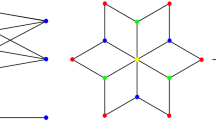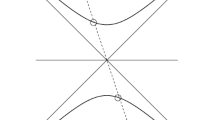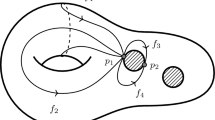Abstract
Building on work of Mondino–Scharrer, we show that among closed, smoothly embedded surfaces in \({\mathbb {R}}^3\) of genus g and given isoperimetric ratio v, there exists one with minimum bending energy \({\mathcal {W}}\). We do this by gluing \(g+1\) small catenoidal bridges to the bigraph of a singular solution for the linearized Willmore equation \(\Delta (\Delta +2)\varphi =0\) on the \((g+1)\)-punctured sphere \({\mathbb {S}}^2\) to construct a comparison surface of genus g with arbitrarily small isoperimetric ratio \(v\in (0, 1)\) and \({\mathcal {W}}< 8\pi \).
Similar content being viewed by others
References
Bauer, M., Kuwert, E.: Existence of minimizing Willmore surfaces of prescribed genus. Int. Math. Res. Not. 10, 553–576, 2003
Canham, P.: The minimum energy of bending as a possible explanation of the biconcave shape of the human red blood cell. J. Theor. Biol. 26(1), 61–81, 1970
Helfrich, W.: Elastic properties of lipid bilayers: theory and possible experiments. Zeitschrift für Naturforschung C 28(11–12), 693–703, 1973
Kapouleas, N.: Minimal surfaces in the round three-sphere by doubling the equatorial two-sphere I. J. Differ. Geom. 106(3), 393–449, 2017
Kapouleas, N., McGrath, P.: Generalizing the linearized doubling approach and new minimal surfaces and self-shrinkers via doubling. Cambridge J. Math. (to appear). arXiv:2001.04240.
Kapouleas, N., McGrath, P.: Minimal surfaces in the round three-sphere by doubling the equatorial two-sphere II. Commun. Pure Appl. Math. 72(10), 2121–2195, 2019
Keller, L.G.A., Mondino, A., Rivière, T.: Embedded surfaces of arbitrary genus minimizing the Willmore energy under isoperimetric constraint. Arch. Ration. Mech. Anal. 212(2), 645–682, 2014
Ketover, D., Marques, F.C., Neves, A.: The catenoid estimate and its geometric applications. J. Differ. Geom. 115(1), 1–26, 2020
Kusner, R.: Comparison surfaces for the Willmore problem. Pacific J. Math. 138(2), 317–345, 1989
Kusner, R.: Estimates for the biharmonic energy on unbounded planar domains, and the existence of surfaces of every genus that minimize the squared-mean-curvature integral. In: Elliptic and Parabolic Methods in Geometry (Minneapolis, pp. 67–72. MN, 1994). A K Peters, Wellesley, 1996
Kusner, R., Mondino, A., Schulze, F.: Willmore bending energy on the space of surfaces, MSRI Emissary, Spring, 2016. https://www.msri.org/system/cms/files/204/files/original/Emissary-2016-Spring-Web.pdf
Kuwert, E., Li, Y.: Asymptotics of Willmore minimizers with prescribed small isoperimetric ratio. SIAM J. Math. Anal. 50(4), 4407–4425, 2018
Li, P., Yau, S.T.: A new conformal invariant and its applications to the Willmore conjecture and the first eigenvalue of compact surfaces. Invent. Math. 69(2), 269–291, 1982
Mondino, A., Scharrer, C.: A strict inequality for the minimization of the Willmore functional under isoperimetric constraint. Advances in Calculus of Variations, p. 000010151520210002, 2021
Ndiaye, C.B., Schätzle, R.M.: New examples of conformally constrained Willmore minimizers of explicit type. Adv. Calc. Var. 8(4), 291–319, 2015
Scharrer, C.: Embedded Delaunay tori and their Willmore energy. Nonlinear Anal. 223, 113010, 2022
Schygulla, J.: Willmore minimizers with prescribed isoperimetric ratio. Arch. Ration. Mech. Anal. 203(3), 901–941, 2012
Simon, L.: Existence of surfaces minimizing the Willmore functional. Commun. Anal. Geom. 1(2), 281–326, 1993
Weiner, J.L.: On a problem of Chen, Willmore, et al. Indiana Univ. Math. J. 27(1), 19–35, 1978
Acknowledgements
We thank Nikos Kapouleas, whose constructions of minimal surfaces via linearized doubling inspired this approach to solving the Canham existence problem.
Author information
Authors and Affiliations
Corresponding author
Additional information
Communicated by S. Müller
Publisher's Note
Springer Nature remains neutral with regard to jurisdictional claims in published maps and institutional affiliations.
Appendix A. Mean Curvature on a Catenoidal Bridge
Appendix A. Mean Curvature on a Catenoidal Bridge
In this appendix, we estimate the mean curvature of a small catenoidal bridge in \({\mathbb {S}}^3\). This was done in [5, Example 2.15], but we summarize the argument in order to keep the exposition self-contained.
Define a parametrization \(E :(0, \pi ) \times (-\pi , \pi ) \times (-\frac{\pi }{2},\frac{\pi }{2} ) \rightarrow {\mathbb {S}}^3\) by

We take \(({r}, \theta , {z})\) as local coordinates for \({\mathbb {S}}^3\). The pullback metric is
and the only nonvanishing Christoffel symbols are
Define a map \(X: [-\underline{{{{s}}}}, \underline{{{{s}}}}] \times (-\pi , \pi ) \rightarrow {\mathbb {R}}^3\) by
where \(\underline{{{{s}}}}\) is defined by the equation \(\tau \cosh \underline{{{{s}}}}= 9 \tau ^\alpha \).
Calculation shows that the pullback metric in \(({{{s}}}, \vartheta )\) coordinates is
where \({r}= {r}({{{s}}}, \vartheta )\) and \({z}= {z}({{{s}}}, \vartheta )\), and that
is a unit normal field along the image of X. We compute the second fundamental form A of X using the formula \(A = \left( X^{k}_{, \alpha \beta } + \Gamma _{lm}^{k} X^l_{, \alpha } X^{m}_{, \beta }\right) g_{kn}\nu ^n dx^\alpha dx^\beta \), where X is as in A.2, we have renamed the cylinder coordinates \((x^1, x^2): = ({{{s}}}, \vartheta )\), and Greek indices take the values 1 and 2 while Latin indices take the values 1, 2, 3, corresponding to the coordinates \({r}, \theta , {z}\). Using the preceding and the Christoffel symbols in (A.1), we find
where in the second equality we have estimated using that \( \sqrt{ 1+ \tan ^2 {z}{\,\hbox {sech}}\,^2 {{{s}}}} = 1+ O({z}^2)\) and that \(\frac{1}{2}\sin 2{r}{\,\hbox {sech}}\,{{{s}}}= \tau + O({r}^3)\). Finally, using that \({r}^2 g^{{{{s}}}{{{s}}}} = 1+ O({z}^2)\) and \({r}^2 g^{\vartheta \vartheta } = 1+O({z}^2 +{r}^2)\), we estimate
Rights and permissions
Springer Nature or its licensor (e.g. a society or other partner) holds exclusive rights to this article under a publishing agreement with the author(s) or other rightsholder(s); author self-archiving of the accepted manuscript version of this article is solely governed by the terms of such publishing agreement and applicable law.
About this article
Cite this article
Kusner, R., McGrath, P. On the Canham Problem: Bending Energy Minimizers for any Genus and Isoperimetric Ratio. Arch Rational Mech Anal 247, 10 (2023). https://doi.org/10.1007/s00205-022-01833-w
Received:
Accepted:
Published:
DOI: https://doi.org/10.1007/s00205-022-01833-w




